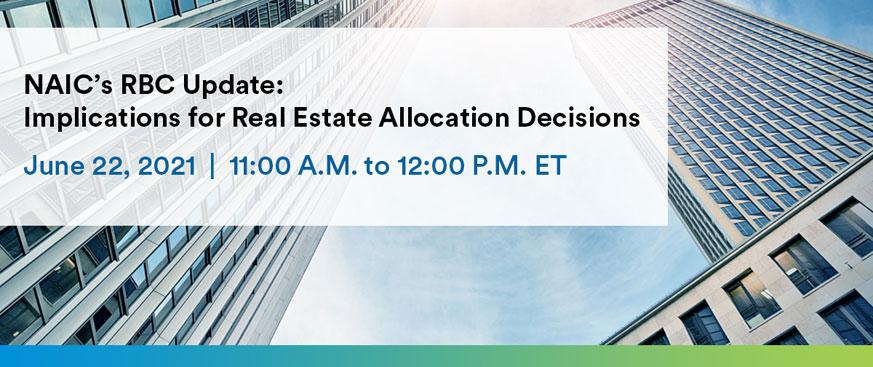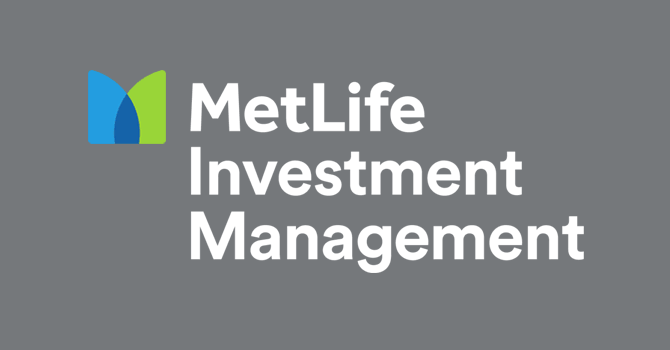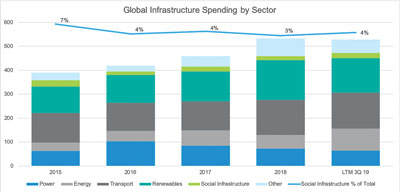


Madhavi Chugh
Managing Director
Institutional Client Group - Insurance
+1-609-216-6691
madhavi.chugh@metlife.com
About MetLife Investment Management
MetLife Investment Management (MIM) enables insurance companies to leverage the 150-year history of our parent, MetLife, Inc., and partner together to invest on their behalves. MIM has a long track record of investing for insurance companies globally; we combine this experience with a client-centric approach and deep asset class expertise. Focused on managing private debt, real estate and public fixed income, we aim to create customized portfolio solutions across the risk spectrum, including income oriented, constrained portfolios as well as total return strategies. We listen first, strategize second, and collaborate constantly to meet clients’ long-term investment objectives.
NAIC’s RBC Update: Implications for Real Estate Allocation Decisions
On May 27th, 2021, NAIC’s Life RBC Working Group approved an ACLI-sponsored proposal to reduce risk-based capital (RBC) factors for real estate equity (REE). MetLife Investment Management hosted an interactive moderated panel discussion to discuss these changes and the investment implications for life insurance companies.
Recovery Risks at Mid-Year 2021
he Great Recovery of 2021 has so far been volatile and difficult to navigate. The remainder of the year could be at least as difficult with the added stress of potential Central Bank actions, which themselves are highly dependent on ever-changing data signals. We examine the greatest risks to our 2021 forecast.
Technical Analysis Chart Pack July 2021
The G4 government bond yields have been grinding lower from their recent peaks for last few weeks. The immediate downtrend may continue. US 2s10s yield curve spread seems to be more predictable than the 10yr yield level. Continued equity rally and tightening HY spread suggest that market sentiment remains bullish. US Dollar is stabilizing. Commodity rallies are intact, while they are approaching key resistances.
The Case for Investing in Floating Rate Bank Loans
With the economy expanding rapidly, growth in GDP is bringing the customary inflationary pressures along with expectations of rising interest rates. Given the supportive economic backdrop, we see value in floating bank loans. We will explore different segments of the bank loan market and highlight potential benefits and risks of the asset class.
Just Because You Call It a Recession Doesn’t Make It One
Although the COVID crisis caused significant economic disruption and has been defined as a recession, actions to stabilize the economy eliminated many of the positive effects that recessions can have including the failure of non-productive businesses. As a result, it is unlikely we are in a new business cycle. Rather, it is more likely we are returning to the business cycle of early 2020, albeit with significant changes to consumer and monetary and fiscal authority balance sheets.
NAIC’s RBC Update: Implications for Real Estate Allocation Decisions
MetLife Investment Management will host an interactive moderated panel discussion to discuss these changes and the investment implications for life insurance companies.
Investment Open For Business: Our Summer 2021 Commercial Real Estate Outlook
In our most recent commercial real estate outlook, we outline why cap rates may fall during the second half of 2021, explore recent work-from-home and office leasing trends, and comment on the unique “K” shaped nature of the economic downturn/recovery.
Episode 47: The Long and Winding Road: Opportunities and Challenges Facing Insurance Companies
Join host Stewart Foley on the InsuranceAUM.com Podcast as we explore the challenges and opportunities shaping insurance investment strategies in today’s evolving economic landscape.
MetLife Investment Management Strategies
Taxable Municipals: Market Review and Outlook
The Taxable Municipal market rallied aggressively in the first quarter. In our 1Q21 market review and outlook, we discuss what triggered this and explore market conditions and events that are likely to influence the asset class going forward.
A Stigmatized Sector—Our Outlook for U.S. Hotel Investments
Today, the hotel sector continues to face challenges, but we believe the most difficult period for hotel demand is behind us. In the very short-term, we believe investors who can provide liquidity to the hotel market can potentially achieve attractive returns.
Short & Intermediate Duration: Q1 2021 Recap, Performance & Outlook
In our latest report, we recap market impacts to short and intermediate duration fixed income assets for Q1 2021 and how that impacted our strategy as well as performance.
Emerging Markets: Market Review and Outlook
In our first quarter Emerging Markets review and outlook, we review current market conditions and global events as they relate to this asset class.
Investment Grade Corporate: Market Review and Outlook
Technical Analysis Chart Pack: April 2021
Fundamental economic data continues to support the continued risk-on market sentiment. Learn more in our latest technical analysis chart pack.
Quantitative Portfolio Strategy: Pension & Insurance – Applying A Risk Parity Strategy to a Fixed-Income-Only Portfolio
Avoiding the Crowds: Finding Opportunities in Private Structured Credit
In most fixed-income markets we are back to where we started in 2020 with low rates, tight spreads and warnings from some that asset prices across sectors may be overheated. What are fixed-income investors to do? For MIM’s Private Structured Credit strategy, it’s back to the basics – trying to identify higher-yield, investment grade opportunities that don’t fit neatly into the traditional asset-backed securities market or private securities market and work with borrowers to find financing solutions for these non-conforming sectors.
Emerging Markets 2021: Key Themes for EMBI Investors in a Post Pandemic World
Still Chained: N95 Masks and Supply Chains Lessons During COVID-19
Supply/Demand Mismatches and 2020 Economic Growth
Buying into the Energy Future
What's the Worst that Could Happen?
The Blockchain Blockbuster: Yapese Stones to Central Bank Digital Currencies
Blockchain, a revolutionary way of transmitting information trustlessly through time, has captured the imaginations of software developers, economists, and now, central bank policymakers worldwide. Blockchain is a version of distributed ledger technology, a system whose fundamental structure dates back hundreds of years to the Micronesian island of Yap.1
Private Capital Quarterly Investment Update (4Q 2020)
How to Stop Worrying and Learn to Love Inflation
Technical Analysis Chart Pack: Jan 2021
A Multispeed Recovery – 2021 Global Risks
Commercial Real Estate Outlook 2021: The winding path to recovery
Seeing the Forest from the Trees: A closer look at SRI investing
Episode 26: Exploring Opportunities in Emerging Markets
Join host Stewart Foley on the InsuranceAUM.com Podcast as he explores emerging market debt, income opportunities, and risk considerations for insurance investors.
High Yield for Insurance Companies: For Everything There is a Season
High yield corporate bonds and bank loans are core asset classes within many insurers’ strategic asset allocation frameworks. While insurers’ exposure to high yield declined in recent years as a result of de-risking actions taken late in the credit cycle, this trend likely has reversed in H1 2020 mainly due to the large magnitude of ratings downgrades; namely fallen angels. Given the complexity of managing insurance company investment portfolios and the inherent higher risk nature of high yield, there are many factors for insurers to consider when assessing the optimal exposure, pursuing portfolio sales and evaluating new investments in the asset class.
Investors Expect and Demand Meaningful Environmental Goals and Progress
There is no doubt that environmental, social and governance (ESG) principles play an increasingly influential role in investment management today. For real estate investors in particular, climate change has arrived as a material risk both in terms of physical risk from floods, hurricanes, and wildfires, as well as transitional risk such as compliance, insurance, and tax increases.
The Social Infrastructure Funding Gap in the United States
The need for investment in U.S. transportation and energy has received a great deal of publicity in recent years. However, the attention on the country’s aging social infrastructure has been less prevalent.









 PODCAST
PODCAST
























